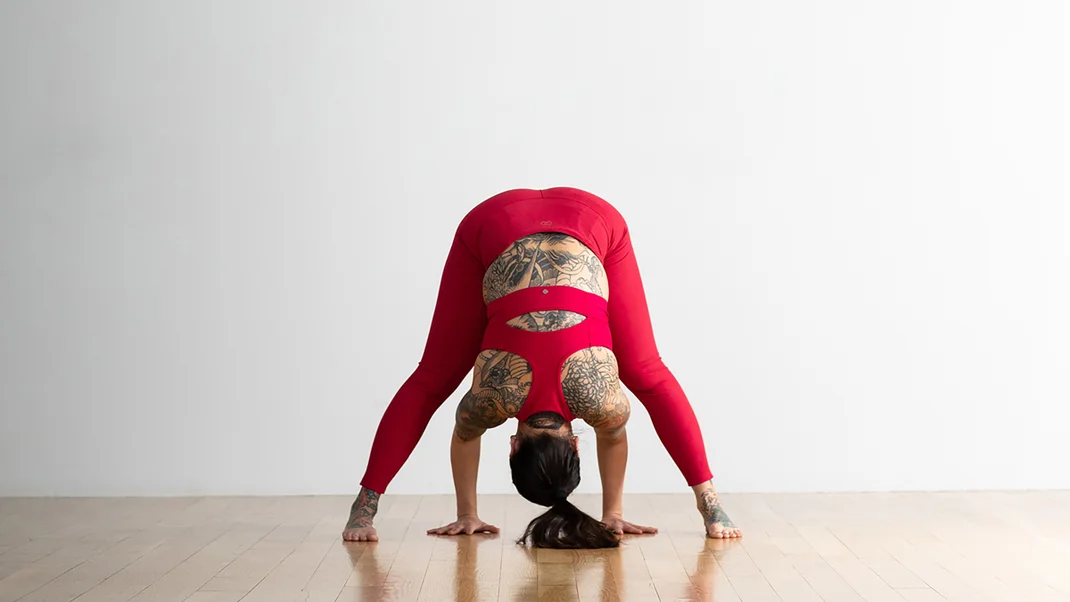Ever find yourself fixated on stretching a particular part of your body? It makes sense to seek a solution for whatever your situation, whether you need stretches for tight hamstrings or poses to ease low back pain.
But despite your desire to zero in on a specific area, that’s not how your body works. Everything is interconnected. Just as you can’t fully appreciate the experience of daylight without also experiencing night, you can’t stretch a particular muscle without acknowledging—or at least inadvertently incorporating—the muscles that support it.
Take those tight hamstrings as an example. Understanding exactly how they and nearby muscles support one another isn’t essential for you to stretch and find some relief. But understanding how your hip flexors can contribute to the problem—and, in turn, help alleviate it—enables you to more fully address the situation.
The anatomy of tight hamstrings and hip flexors
The degree to which you can benefit from any hamstring stretch is determined, in part, by the flexibility and strength of your hip flexors. Known as the iliopsoas, this muscle group includes the psoas major and minor and originates at the lumbar spine and attaches to the femur (thigh bone). The contraction of these muscles causes forward flexion, or bending at the hip joint, as well as lateral flexion, or bending the torso to the side.

The hamstrings comprise three muscles that originate on the ischial tuberosity (your sit bones), run along the back of the thigh, cross behind the knee joint, and attach to the lower leg. When your knee bends, the hamstrings contract. When your leg straightens, they lengthen.
The contraction, or shortening, of the psoas muscle happens in tandem with the lengthening, or stretching, of the hamstring muscles. For example, in a forward bend, the iliopsoas contracts to help you bend forward at your hips, which lengthens the hamstrings. In a standing pose that asks you to draw one knee toward your chest, you engage the iliopsoas muscles to lift the leg, which indirectly causes the hamstring of that same leg to lengthen.
But if the hip flexors are tight or weak, this can lead to an anterior (forward) tilt of the pelvis. This forward tilt, ironically, creates tension in the hamstring. Instead of helping your hamstrings become more flexible, this constant tugging causes them to feel even tighter.
When you understand the interplay between these muscles, you can begin to build a collection of stretches for tight hamstrings that also stretch and strengthen your hip flexors, resulting in greater relief than you could experience by focusing exclusively on your hamstrings.
6 stretches for tight hamstrings and hip flexors

Anjaneyasana (Low Lunge)
What it does: Stretches the hamstrings of the front leg and the psoas of the back leg.
How to: Start in Adho-Mukha Svanasana (Downward-Facing Dog Pose). Step your right foot in between your hands and lower your back knee to the mat or a folded blanket. Lift your torso until your shoulders stack over your hips or place your hands on blocks alongside your front foot in Low Lunge. Stay here and breathe. Repeat on the other side.
Tips:
To intensify the psoas stretch, subtly lift your pubic bone toward your navel.
To simultaneously stretch and strengthen your front hamstring, imagine dragging your front heel toward the back of the mat without moving your foot.

Prasarita Padottanasana (Wide-Legged Standing Forward Bend)
What it does: Stretches the hamstrings and hip flexors of both legs. (Even though you might expect the forward fold to shorten the psoas muscle, the position of the legs away from the body actually lengthens it.)
How to: Start in a wide-legged stance with your feet 3 to 4 feet apart and parallel to one another or slightly pigeon-toed. Hinge forward at your hips and place your hands on the floor or blocks in Prasarita Padottanasana. Press down through the outer edges of your feet and lift up through the arches. Soften your belly and shift your gaze between your legs. Relax and lengthen your neck so the crown of your head releases toward the mat. Draw your shoulders away from your ears. Contract the muscles on the front of your legs to help prevent you from feeling like you are going to fall forward. Draw your inner thighs toward the pubic bone and turn them in slightly to release tension in your lower back. Stay here and breathe.
Tip
To ensure you get the most of this stretch for tight hamstrings, practice the pose with the backs of your thighs and heels against a wall. This keeps your hips aligned over your heels rather than allowing them to shift backward, which reduces the stretch.
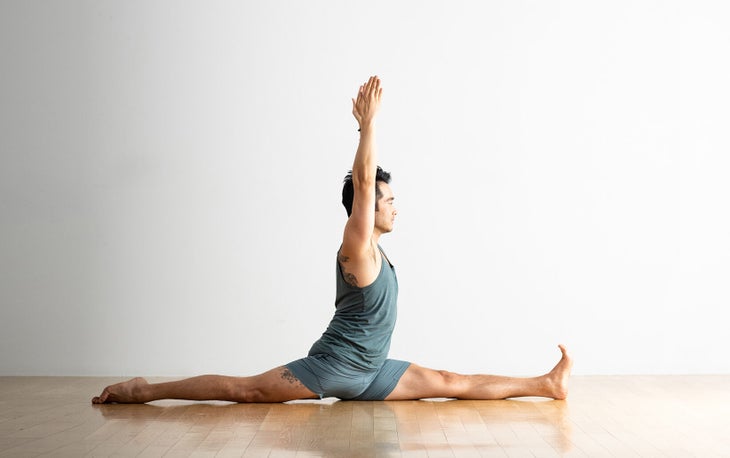
Hanumanasana (Splits or Monkey Pose)
What it does: Stretches the hamstrings of the front leg and the psoas of the back leg.
How to: Start in Low Lunge and lengthen your tailbone toward the back of your knee. Straighten your front leg, inching your heel forward so your hips maintain alignment over your back knee in Half Splits. If you want to come into Splits, keep your shoulders stacked over your hips (you can use blocks under your hands if needed) and start to inch your back knee further away from you. Keep reaching the tailbone down toward the mat and lifting the pubic bone up toward the navel as you come into Splits. Turn your front thigh out slightly to keep your front knee facing the ceiling. Roll your back thigh inward and down until your hips are an equal distance from the mat. Relax your shoulders away from your ears as you draw your front ribs in. Stay here and breathe. Repeat on the other side.
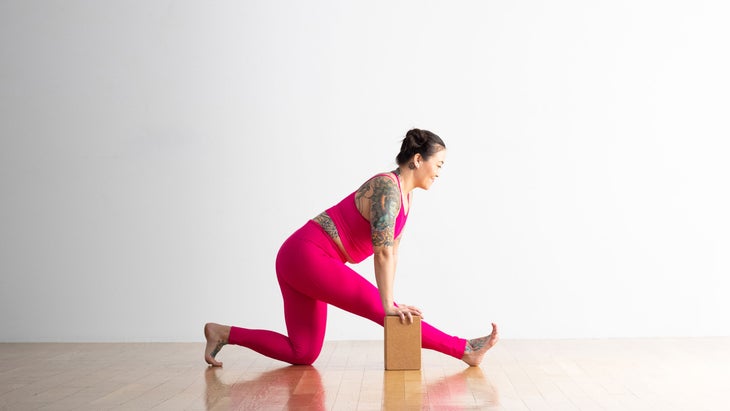
Tip: You can opt to stay in Half Splits with your fingertips on the mat or your hands on blocks. Keep your torso upright or fold forward over your front leg with a straight spine. (Note: Although Half Splits is one of the most effect stretches for tight hamstrings, it won’t stretch the hip flexors.)

Paschimottanasana (Seated Forward Bend)
What it does: Stretches the hamstrings of both legs and strengthens the hip flexors.
How to: Sit with your legs straight in front of you. If you have tight hip flexors or low back pain, sit on the edge of a folded blanket to prevent rounding in your lower back. Lengthen your spine and inch your sit bones a little further away from your heels. Keep your feet flexed as you hinge at your hips and reach your chest toward your toes. When you cannot reach any further, pause in Paschimottanasana. Keep as much of a bend in your knees. You can keep your spine elongated and grasp the outer edges of your feet, ankles, or calves or let your back round, releasing your chin toward your chest. Stay here and breathe.
Tips
This stretch for tight hamstrings can also strengthen them if you reach through your heels and press your thighs into the mat.
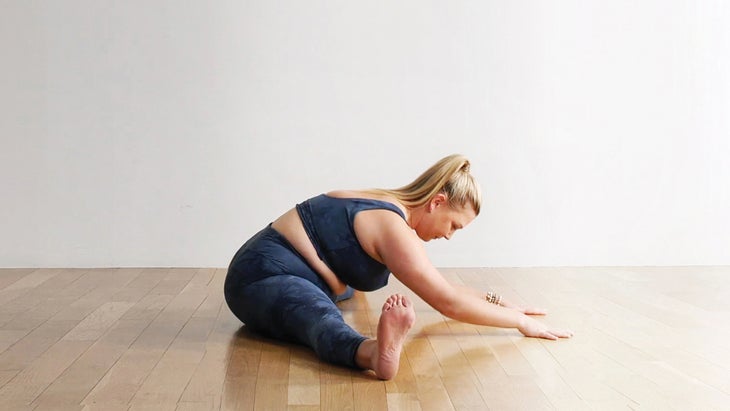
Upavistha Konasana (Wide-Angled Seated Forward Bend)
What it does: Stretches the hamstrings and hip flexors of both legs. (Even though you might expect the forward fold to shorten the psoas muscle, the position of the legs away from the body actually lengthens it.)
How to: Start seated with your legs a relatively comfortable distance apart. Hinge forward at your hips and place your hands on the floor or blocks in front of you. Soften your belly and shift your gaze between your legs. Relax and lengthen your neck so the crown of your head releases toward the mat in Upavistha Konasana. Draw your shoulders away from your ears. Contract the muscles on the front of your legs to help prevent you from feeling like you are going to fall forward. Draw your inner thighs toward the pubic bone and turn them in slightly to release tension in your lower back. Stay here and breathe.
Tip
You can keep your knees slightly bent to ease the intensity on your hamstrings. Try sliding rolled blankets or towels behind your knees.
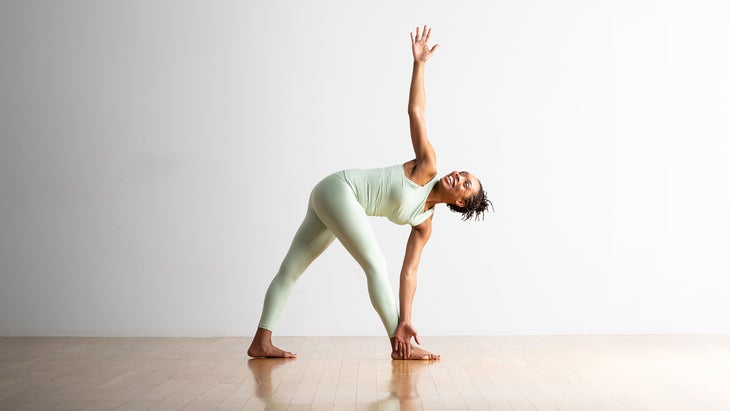
Parivrtta Trikonasana (Revolved Triangle Pose)
What it does: Stretches the hamstrings of both legs and strengthens the hip flexors. Tight or weak hip flexor muscles can cause rounding at the low back in the pose and create additional stress on the hamstrings.
How to: Begin in Pyramid Pose with your hands on the mat or on blocks inside your front foot. Press into the mat or blocks to encourage lengthening through the chest. Reach your right arm toward the ceiling and let your bottom ribs initiate the twisting motion of your chest in Revolved Triangle Pose. Think of your rib cage as a spinning barrel to prevent your lower front ribs from jutting forward and your low back from arching. Lift your thigh muscles toward your hips as if they were hugging the femur bones. Stay here and breathe. Repeat on the other side.
